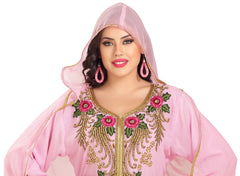
The kaftan or more generally "kaftane" in Moroccan got its initial appearances in age-old Persia (Iran at present). Several versions endure in reference to the creation of their thoughts, begun from the attire of the Ottoman sovereignty for some or a reinterpretation of Roman draperies for others. And very first information Takchita/Kaftan is the same thing.
It was originated in the Muslim East in the 8th century and in Morocco, at the conclusion of the 11th century, gratitude to the inheritance of Andalusians dwelled in the Maghreb. In the beginning, carried by affluent men and nobles, the kaftan was a representation of wealth.
The Moroccan Kaftan designer continues on being an influential component of Morocco's social reputation. Kaftan is the self-esteem of each Moroccan lady. It expresses her.

straightforwardness and her intricacy; her womanhood and grace; her mirth and delicacy; and her enchantingly brilliant and impressionable appearances.
Kaftan/Takchita of Fes
Old and blue-blooded city, Fassi kaftans are formed in brocade, natural silk or stitched or smooth velvet. Embroideries in gold or silver thread come embellished with the neckline, sleeves, and joints.
Kaftan/Takchita of Rabat
It resembles at the beginning of the 20th century. It is distinguished by narrow sleeves and a cut adjacent to the body, it was soon embraced by the city-dwellers considering it is stocked easily beneath the jellaba.

Women throughout the world are now acknowledging the Designer Moroccan clothes more of a mundane attire that harmonizes all and every peculiar criterion of charm and high quality universal. The Designer Moroccan Takchita stands up as everlasting apparel that earns more magnificently with intervals to endure and face even in an age of cataclysmic style and design.









